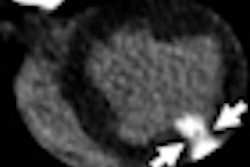Doctors reported a minor role for ventilation-perfusion (V/Q) scintigraphy in select patients, and MRI, currently being evaluated for the indication, was hardly an afterthought.
"Advances in CT … have greatly altered the diagnosis of a host of conditions, including pulmonary embolism," wrote Dr. Saurabh Jha and colleagues from the University of Pennsylvania in Philadelphia. "The PIOPED II trial confirmed the utility of CT in diagnostic decision making and showed it superior to V/Q scintigraphy in the detection of pulmonary embolism."
Though CT has largely replaced catheter angiography as the reference standard, it can't be recommended in all patients; for example, in those allergic to iodinated contrast, and those with renal failure.
In pregnant patients, several approaches, including Doppler ultrasound, are used, but CT is sometimes needed. V/Q is an important second-line modality, but the value of the results, which show a high or low probability of PE, can be limited.
The survey queried approaches to PE diagnosis in a broad range of patient circumstances. Online questionnaires were sent to Pennsylvania emergency physicians and radiologists.
In all, 62 radiologists and 52 emergency physicians completed the survey. Some 90% of radiologists and 96% of emergency physicians preferred CT as their first-line choice. V/Q scintigraphy was considered a backup measure when faced with contraindications.
Emergency physicians cited accuracy (90%) as the main reason for favoring CT, followed by availability (85%), and potential for alternative diagnosis (50%). Two respondents chose MRI as a potential alternative, though 56% of facilities did not offer it.
D-dimer testing was performed in 62% of cases; a Wells score was obtained for 65%. Most survey respondents requested radiography routinely, but only 19% believed it affected their decision to request more imaging.
"Seventy-six percent of emergency physicians replied that on occasion they discussed with the radiologists the appropriate technique for the clinical situation," Jha et al wrote. Availability and continued dose reduction were frequently cited as concerns about CT.
By AuntMinnie.com staff writers
December 23, 2009
Related Reading
SPECT as accurate as CT for diagnosing pulmonary embolism, December 17, 2009
CT supplants V/Q scanning for pulmonary embolism detection, October 20, 2009
At CT, not all pulmonary embolism are bad pulmonary embolism, February 4, 2009
Dual-energy CT helps distinguish pulmonary embolism from other perfusion defects, December 2, 2008
Copyright © 2009 AuntMinnie.com




















